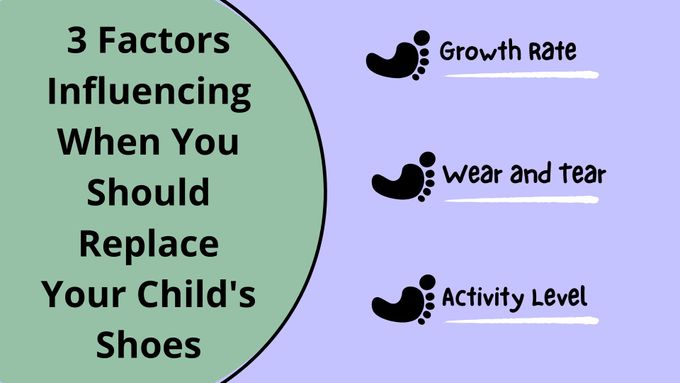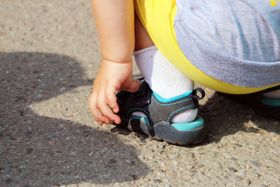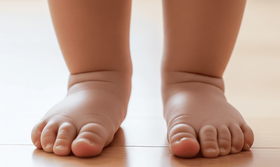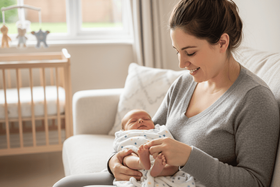How Often Should You Replace Your Childs Shoes?
Kids' shoes need to be replaced regularly as wearing improperly fitting shoes as a youngster may increase your risk of developing long-term foot issues including hammertoes, bunions, and flat feet.
Updated December 6, 2024
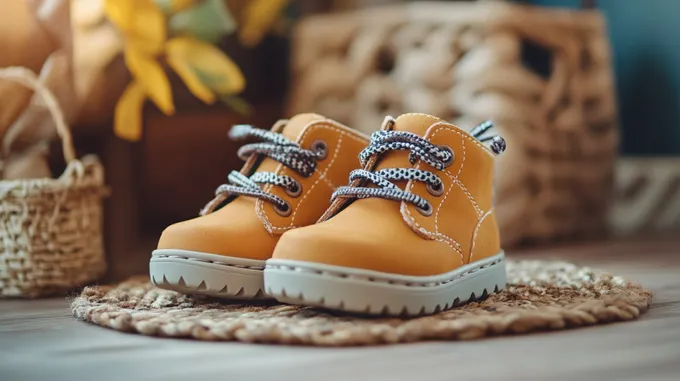
Ensuring that your kids have shoes that fit is a crucial aspect of being a parent. The American Podiatric Medical Association (APMA) estimates that 60–70% of kids may wear shoes that are too small. Parents may minimize the risk of damage and encourage healthy foot growth for their children by replacing shoes as soon as necessary, ensuring that the feet are adequately supported.
Visible wear on the tread or outsole, worn-down or flattened padding, and the child's complaints of pain or discomfort when wearing the shoes are common clues that the shoes need to be replaced.
» Shoes breaking too fast? See these durable shoes for active kids
Risks of Poorly-Fitting Shoes for Kids
For various reasons, children's foot growth and health depend on well-fitting shoes, and improperly fitting shoes can cause several problems:
- Future malformations: Since a child's feet are still growing and developing, improperly fitting shoes can disrupt normal growth patterns and perhaps cause malformations or other issues with the feet in the future.
- Risk of accidents: Shoes that are too loose may not offer enough support and stability, increasing the risk of injuries and other accidents.
- Friction injuries: Shoes that are too tight can result in pain, blisters, and even impair normal circulation. As growing bones, muscles, and ligaments need support and protection, appropriately fitting shoes encourage healthy foot growth
» Not sure if they need new shoes? Here's how to measure your kids' feet properly
According to research, wearing improperly fitting shoes as a youngster may increase your risk of developing long-term foot issues including hammertoes, bunions, and flat feet.
» See our list of the best orthopaedic shoes for kids with flat feet
What Experts Say About Replacing Your Child's Shoes
Podiatrists, footwear specialists, and paediatricians are frequently the ones who offer professional advice and guidance for updating children's shoes, and here's what they say:
Also, pediatricians suggest parents check their child's shoe size every few months, particularly during times of fast development, and replace shoes as soon as they start to show wear or become too small.
» Looking for some great options? Consider the best shoes with built-in arch support
Common Times to Replace Your Child's Shoes
The general rules on how often to replace your kids’ shoes might change depending on a few factors:
- Age: Kids go through growth spurts, which means that they grow at different rates throughout their childhoods, which means that they may require more or less frequent shoe replacements at different stages of their lives.
- Intensity of activity: Children who are highly active and participate in sports or outdoor activities may need to replace their shoes every 3-6 months
- Shoe quality: Quality shoes constructed from sturdy materials could endure longer and need to be replaced less frequently than less expensive, inferior models. While your kids' shoe replacement schedules will mostly likely be due to them outgrowing the shoes, poor quality shoes on active kids will degrade much faster and need to be replaced more frequently.
» Make sure you know how to choose kids' shoes for different stages of foot development
Child Shoe Replacement Guidelines
Infants/Toddlers
Since an infant's or toddler's feet develop so quickly, it's best to measure their feet every 2-3 months and replace them as soon as needed.
Preschool/Primary School
Children usually go through growth spurts in the preschool and primary school years, which may require replacements more frequently. You should consider replacing their shoes every 4-6 months.
Puberty
Once kids have gone through puberty, their growth rate generally stabilizes and they need shoe replacements less often. Consider checking and replacing their shoes every 6-12 months.
Young Adulthood
Most kids' feet stop the majority of growth around 16 for boys and 14 for girls, though some may continue to grow until around 18-20 years of age. At this point, your children should be able to inform you if they need new shoes.
» Just bought new shoes? Here's how to help your kids break them in
3 Factors Influencing When You Should Replace Your Child's Shoes
1. Growth Rate
Several factors can affect how big a child's feet develop, such as an unhealthy or healthy diet, general health, and heredity. The foot's bones, muscles, ligaments, and other tissues are always growing and changing, which causes variations in the foot's size, shape, and arch height.
Shoes that fit properly one month may become too small the next due to this fast development, which can cause discomfort and possibly even foot issues. During these development spurts, it's crucial to replace children's shoes frequently to make sure there's enough space for their feet to expand and develop freely.
» See our list of the top shock-absorbing shoes for active kids
What Influences Foot Growth Rate in Children?
Although age and gender-based general tendencies exist in foot growth, every kid is different and has a distinct growth trajectory. For instance, twin brothers may have remarkably varied foot sizes and rates of growth throughout development.
Conversations with parents often disclose fascinating insights regarding their child's development, including dietary patterns, exercise levels, and overall health, all of which can influence foot growth.
Early childhood growth rates average around one shoe size each year, and this fast development slightly slows down when kids get into preschool and primary school.
I have observed that boys often grow their feet a little quicker than girls, especially throughout puberty. Also, as foot size tends to run in families—genetics have a big influence on how big and how shaped a child's feet turn out.
» Understand the difference between regular shoes and supportive shoes
2. Physical Signs of Wear and Tear
Indicators of structural integrity can be found by looking at the way the shoes' tread and outsole have worn. A worn-down or uneven tread indicates that the shoes would not provide the necessary support and traction, which raises the possibility of slips and falls.
Parents should be actively involved in keeping an eye on their child's footwear and foot health by highlighting these physical markers during consultations. Sometimes all it takes to get a parent to understand the value of timely replacements is to point out to them the worn-out soles of their child's shoes.
3. Activity Level and Usage
Compared to kids who lead more sedentary lifestyles, children who are very active and engage in sports or outdoor activities typically wear out their shoes faster. Playing, running, leaping, and continual movement can hasten the deterioration of shoes, particularly the outsole and cushioning.
The kind of activities a youngster participates in might also impact the longevity of their shoes. For example, because of the repeated motions and friction on the playing surface, shoes used for sports like basketball or soccer may wear out sooner. Similar to this, shoes used for hiking or other outdoor activities may be subjected to more abrasion from the weather and uneven terrain.
Common Mistakes to Avoid When Considering Replacing Your Child's Shoes
1. Prioritising Comfort Over Style
It makes sense that parents want their kids to wear fashionable shoes, but occasionally this might compromise the shoes' appropriate fit and support. Parents often buy shoes that they think look nice without taking into account important aspects like flexibility, arch support, and cushioning, which are important for keeping their kids' feet healthy.
Even though fashionable shoes might be quite attractive, they sometimes don't have the qualities needed to properly support developing feet. Blisters, pain, and more serious foot problems like bunions, ingrown toenails, or plantar fasciitis can result from wearing shoes that are either too tight, too loose, or don't have enough padding.
» Your kids can be stylish and supported: These stylish white children's shoes
2. Passing Down Worn-Out Shoes to Younger Siblings
Given that they might no longer offer sufficient support or safety, giving old shoes to younger siblings or other kids might have serious negative effects. Once shoes are worn out, their treads become worn down, and their structural integrity is severely weakened. When old shoes are handed down, they don't provide new wearers with the necessary support.
Remember: No two people's feet are alike in terms of size, shape, and arch height, so shoes that have been custom-molded to fit one child's feet could not support or fit another child's feet properly. This fit mismatch might make foot issues worse and prevent the new foot from developing normally.
3. Not Checking Your Kids' Shoes Regularly
Since kids grow so quickly, parents often fail to notice their child's growing foot size or ignore wear and tear on their child's shoes. Children may wear shoes that are too small or worn out as a result, which can cause pain, blisters, and even foot issues.
Stay Up-To-Date With Your Kids' Footwear With First Walkers
Keeping up with your kids' changing shoe needs is crucial to ensure they have adequate room and support for growth and development. Parents may make sure that their children's feet are properly supported and protected by routinely inspecting their shoes for indications of wear and tear and replacing them as necessary.
Thankfully, you don't have to struggle to keep up with your kids' evolving shoe needs as there are plenty of reputable online brands providing various shoe types for kids of different ages. Take a look at our kids' shoe collections to learn more.
» Need help? See our online shoe shopping guide for kids
